While many parts of the world are currently baking under scorching temperatures and suffering through extreme drought, others, like Pakistan, are getting record amounts of rainfall this season. Monsoon downpours deluged portions of Pakistan last weekend and Karachi, the country’s largest city, bore the brunt of the worst impacts as the floodwaters destroyed homes, inundated businesses and damaged infrastructure.
AccuWeather forecasters say the heaviest rainfall from the event arrived Sunday when Karachi received more than triple its monthly rainfall in just 24 hours. Daily life was turned to a standstill as this deluge turned major throughways into raging rivers and left entire neighborhoods submerged. Images from the city showed residents navigating floodwaters that ranged from knee-high to chest-high in spots. Vehicles were left stranded as floodwaters climbed.
The catastrophic flooding event left all major highways in Karachi flooded, according to The Express Tribune. Due to the impossibility of safe travel for large portions of the city, the local government declared Monday a public holiday in Karachi, which closed all government offices and urged private offices to follow suit. Karachi, Pakistan’s financial and industrial hub, is located along the coast of the Arabian Sea. Some of the most densely populated areas of the city are located at, or scarcely, above sea level. The low-lying nature of the city already makes Karachi prone to flooding issues, but inadequately-constructed drainage and flood management systems compound the issue considerably.
Rainwater even mixed with sewage in some locations and this contaminated water rushed into homes and businesses. Murtaza Wahab, the Karachi administrator, told The New York Times that the city has an old drainage and sewage infrastructure that could not cope with the torrential rains and acknowledged that updates were critical. Floodwaters in recent days have damaged more than 5,500 homes as well as critical infrastructure like highways and bridges, according to a report from Pakistan’s National Disaster Management Authority.
This weekend’s flooding was the second destructive flooding event the city has had to endure this month alone. Earlier in July, another deluge of monsoon rainfall left Karachi underwater.
Since the middle of June, monsoon rainfall and subsequent flooding have resulted in more than 280 deaths throughout Pakistan, according to The Associated Press (AP). The amount of rainfall the city has already received this month is astounding, forecasters say. “Karachi received 2.36 inches (60 mm) of rain on Sunday due to a weak monsoon low that formed near southwestern Rajasthan, India, over the weekend,” AccuWeather Lead International Forecaster Jason Nicholls explained.
According to AccuWeather, so far this July, the city has recorded just over 8 inches (200 mm) of rainfall which equates to 1,147 percent of normal for the month, according to Nicholls. Karachi typically receives less than an inch (25 mm) of rain in July and just over 1.50 inches (38 mm) of rain over the course of the summer months. Furthermore, even in the highly unlikely event that not a single drop of rain falls in Karachi for the rest of the year, the city would still end 2022 with over 260 percent of its normal precipitation.
The monsoon normally arrives in Pakistan around July 8, but this year it arrived several days early, according to Nicholls. “Part of the reason for the excessively wet July is that the monsoon [axis] has been located south of its normal position for much of the month,” Nicholls explained. Instead of directing the heaviest rain over northern India and around the sub-Himalayan foothills, the monsoon has instead sent abundant moisture directly to central India and southern Pakistan. “July is the wettest month on average, but there can be bouts of rain into Pakistan until the monsoon withdraws, typically in mid- to late September,” Nicholls cautioned.
Given the current situation across the region, any additional bouts of rain will bring with it increased chances for a repeat of catastrophic flooding. In the short term, forecasters say there is at least some glimmer of hope in the forecast for hard-hit portions of Pakistan struggling to clean up and rebuild. The monsoon axis will lift back north starting around midweek, which should lead to an easing of rain in the region later this week and into the start of August, according to Nicholls.
However, Nicholls also expressed concern that August could be another wetter-than-normal month for Karachi and Pakistan as a whole.
—
Photo Credit: Asianet-Pakistan / Shutterstock.com
